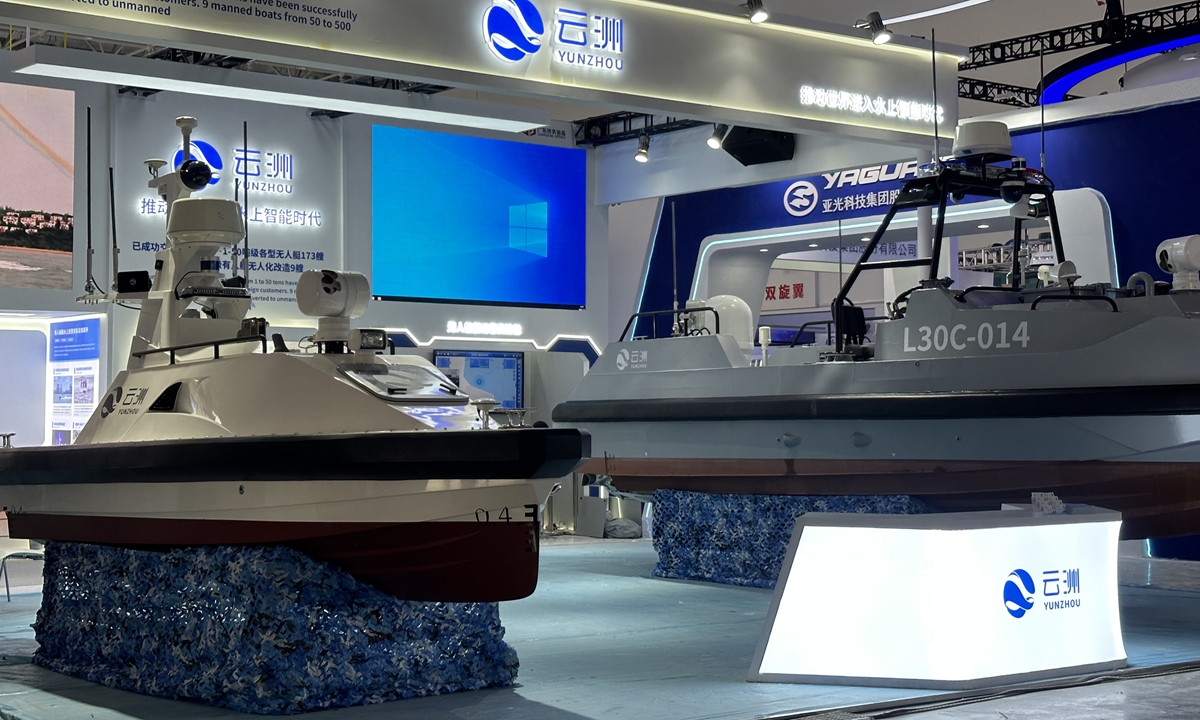
Yunzhou's two types of coastal defense unmanned boat practical boats are on display at Airshow China in Zhuhai, South China's Guangdong Province. Photo: Cao Siqi/GT
Various types of marine equipment, especially intelligent unmanned high-speed vessels, which are playing an important role in safeguarding the country's maritime security and scientific research, are one of the highlights of this year's Airshow China, scheduled to be held from November 8 to 13.
The Global Times learned on Monday that China State Shipbuilding Corporation will demonstrate several advanced capital ship designs at the Airshow, including an amphibious landing ship, a dock landing ship, a conventional submarine, the export type 052DE air defense destroyer, the 3,000-ton class C28A frigate, the 1,700-ton class F15A frigate, as well as multiple types of unmanned underwater vehicles and unmanned patrol boats.
Meanwhile, it also displayed the design of the world's first ship with an intelligent unmanned system, which was launched in Guangzhou, South China's Guangdong Province in May. The ship is developed to meet the requirements of three-dimensional dynamic ocean observation through the aerial and underwater dispatch of unmanned equipment in the field of marine surveys.
It can carry more than 50 sets of unmanned systems and realize the rapid deployment, recovery, transfer, carrying and collaborative operation of unmanned aerial vehicles, unmanned boats and unmanned underwater vehicles. It is the first intelligent marine survey ship in the world with the capability of autonomous navigation in open waters and a remote-control function.
According to previous reports, the equipment on the ship is highly localized, and the core elements such as the power system, propulsion system and operation support system were all independently developed by Chinese scientists.
The ship has a length of 88.5 meters, a width of 14.0 meters, a depth of 6.1 meters, a designed displacement of about 2,000 tons, a maximum speed of 18 knots, and an economic speed of 13 knots.
With a spacious deck, the ship can carry a dozen different observation instruments. Construction of the ship began on July 20, 2021. In the future, the application of the ship will be of great significance for changing the traditional ocean observation mode, obtaining real-time three-dimensional ocean observation data, improving the efficiency and level of ocean observation, and contributing to the training of high-end marine scientific and technological talent and further enhancing the capability of ocean scientific and technological innovation.
The Global Times learned from insiders that it is expected to be put into use by the end of 2022.
Leading developer of unmanned surface vehicles Yunzhou demonstrated two new unmanned vessels at the Airshow.
The Global Times learned from the company that the L30 "Lookout" patrol unmanned boat is about 7.5 meters long, 2.6 meters wide, with a maximum speed of more than 35 knots and an endurance of 220 nautical miles.
"It can carry loads such as radar equipment, optoelectrical equipment, cameras, searchlights and life rafts, and its functions include patrol monitoring, close reconnaissance, target tracking, warning and driving away, anti-terrorism, anti-smuggling, emergency rescue and material delivery," Zhou Zhiyong, general manager of Yunzhou Intelligent Brand, told the Global Times.
The unmanned boats have already performed well in an anti-smuggling patrol campaign in Zhuhai in 2022, a smart border and coastal defense patrol campaign in the Greater Bay Area held in 2021, and the anti-smuggling patrol campaign in Lianyungang held in 2018, according to Zhou.
The M75 "Guardian" security patrol unmanned boat is 5.3 meters long, 1.7 meters wide, and has a maximum sailing speed of 25 knots.
"The boat has a high sailing speed and a shallow draft. It can be deployed and recovered independently, and has the ability of self-righting," Zhou said.
According to the general manager, the vessel has been put into use in the offshore oil and gas platform group near Weizhou Island developed by China National Offshore Oil Corp in the Beihai Sea to carry out small supplies transportation, oil pipeline patrols and guard duties.
"It not only greatly reduces the cargo transportation cost between platforms, but also ensures the long-term safety of offshore oil platform pipelines," Zhou said.
Zhou said the company is also endeavoring to make some breakthroughs in independent research and development, especially on key components and accessories.
In 2021, the company achieved a breakthrough in its dynamic cooperative confrontation technology, which could allow its unmanned high-speed vessel to quickly intercept, besiege and expel invasive targets, marking a milestone in maritime unmanned intelligence equipment development.
Compared with manned vessels, ship drones have the advantages of low cost, multiple functions, strong scalability, high mobility and long duration. They can adapt to special and extreme environments, and they have huge advantages in maritime development and rights protection.
As the basic mode of the future, featuring unmanned intelligent equipment at sea, unmanned ship swarms are the focus of the industry. Domestic research on unmanned ship swarms started late, with the US, Israel and other countries imposing a technological blockade on China.




